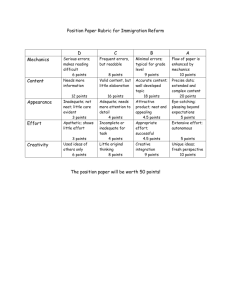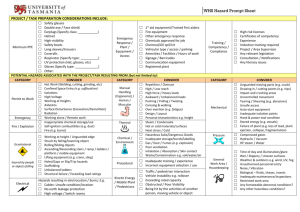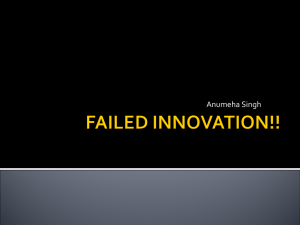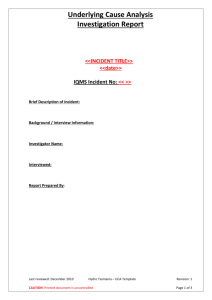The Dangme West District SWOT Analysis The Dangme West
advertisement
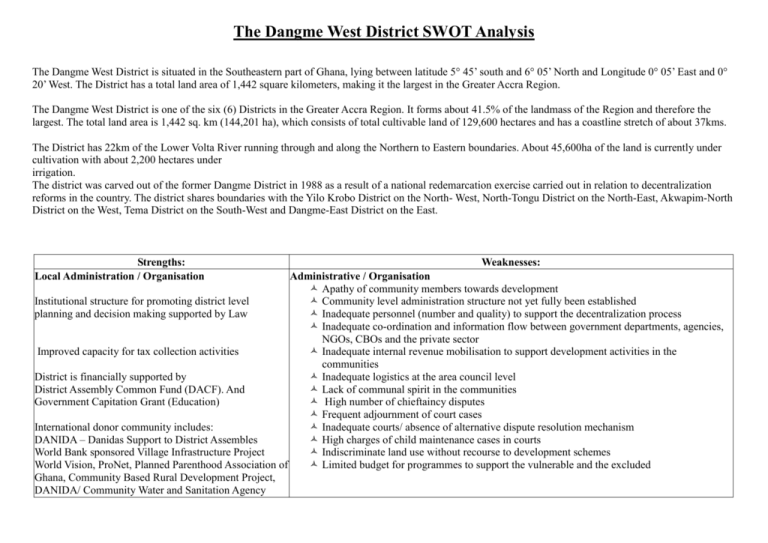
The Dangme West District SWOT Analysis The Dangme West District is situated in the Southeastern part of Ghana, lying between latitude 5° 45’ south and 6° 05’ North and Longitude 0° 05’ East and 0° 20’ West. The District has a total land area of 1,442 square kilometers, making it the largest in the Greater Accra Region. The Dangme West District is one of the six (6) Districts in the Greater Accra Region. It forms about 41.5% of the landmass of the Region and therefore the largest. The total land area is 1,442 sq. km (144,201 ha), which consists of total cultivable land of 129,600 hectares and has a coastline stretch of about 37kms. The District has 22km of the Lower Volta River running through and along the Northern to Eastern boundaries. About 45,600ha of the land is currently under cultivation with about 2,200 hectares under irrigation. The district was carved out of the former Dangme District in 1988 as a result of a national redemarcation exercise carried out in relation to decentralization reforms in the country. The district shares boundaries with the Yilo Krobo District on the North- West, North-Tongu District on the North-East, Akwapim-North District on the West, Tema District on the South-West and Dangme-East District on the East. Strengths: Local Administration / Organisation Weaknesses: Administrative / Organisation Apathy of community members towards development Institutional structure for promoting district level Community level administration structure not yet fully been established planning and decision making supported by Law Inadequate personnel (number and quality) to support the decentralization process Inadequate co-ordination and information flow between government departments, agencies, NGOs, CBOs and the private sector Improved capacity for tax collection activities Inadequate internal revenue mobilisation to support development activities in the communities District is financially supported by Inadequate logistics at the area council level District Assembly Common Fund (DACF). And Lack of communal spirit in the communities Government Capitation Grant (Education) High number of chieftaincy disputes Frequent adjournment of court cases International donor community includes: Inadequate courts/ absence of alternative dispute resolution mechanism DANIDA – Danidas Support to District Assembles High charges of child maintenance cases in courts World Bank sponsored Village Infrastructure Project Indiscriminate land use without recourse to development schemes World Vision, ProNet, Planned Parenthood Association of Limited budget for programmes to support the vulnerable and the excluded Ghana, Community Based Rural Development Project, DANIDA/ Community Water and Sanitation Agency Millennium Challenge Account Compact UNDP Labour Market and HR Economy Local secondary functions, to provide market to stimulate agriculture production. General absence of industries in the district. Current spatial distribution employment patterns and income does not present any competitive advantage for entrepreneurs to want to establish ventures in district In the area of training, there is a District Capacity Agricultural Building Team, part of (District Planning and Heavy soils that are difficult to till during the wet seasons. Coordination Unit) that responsible for training services Over dependence on Rainfed Agriculture. to sub-districts and community level actors. Land fragmentations resulting from the existing land tenure system (private leasehold and family inheritance) The Southeast Green Belt scheme has being implemented with other districts to promote sound environmental protection and sustainable human settlement development. Economy. Agriculture and Trading are largest employers with prospects for development Economy Leading sectors in terms of provision of revenue to the district Assembly and remunerations to workers are the quarries, followed by business operating permits. A 37-kilometre stretch of coastal land along the Gulf of Guinea for tourism, fishing and salt Production Presence of Game Reserves Agriculture Large cultivable land 32,400 ha of vast savannah land for livestock grazing The presence of about 20km stretch of the Volta River for irrigation, fresh water fishing and Low agricultural productivity and output Low prices of agricultural products High cost of farming inputs Low level of infrastructure development Predominant Soil is unsuitable for hand cultivation Inadequate storage facilities High post-harvest losses Vulnerables. Limited in resources to support Vulnerable persons like disabled, aged, children and women. Women are disadvantaged economically from negative tra and face, high child maintenance, increasing rate of divorce, pre-marital child bearing and increasing un-partnered adolescent fertility, Other negative traditional social systems, fertility, conflicts, and gender equity in personal and social relationships. Enrollment figures for schools in the district shows that more boys than girls get enrolled in school and as they progress up the educational ladder more of the girls drop out of school. The worst forms of child labour such as child trafficking for fishing, prostitution; household services etc. are predominant in most communities. There is absence of juvenile courts, child panels or probation homes and institutions to manage juvenile delinquency and orphans face various abuses. transportation. Large livestock population, (Cattle-37, 685+, Sheep and Goat-11,000+ Suitable climatic condition for the cultivation of wide range of crops Establishment of exportable mango plantations Heavy fertile soils good for storing water for irrigation, aqua-culture and watering livestock. Labour Market Human Resources Number of 44 preschools, 71 primary and 45 Junior Secondary schools considered adequate. Education A number of schools and institutions are in varied state of disrepair and needs rehabilitation, refurbishment, or new structures and sewage systems. Other improvement of infrastructure and urgent are staff accommodation, classroom blocks, student dormitories, libraries, recreational centers, furniture, toilet facilities, and potable water in these schools. Infrastructure Limited access to marketing centres due to poor conditions of the feeder road network Poor distribution and supply of electricity to stimulate industrial development physical infrastructure and programmes to build the capacity of the people facing inadequate funding This includes educational infrastructure, health infrastructure, electricity, potable water supply, inaccessible roads and poor road network, poor drainage and in-sanitary conditions, lack of market infrastructure, lack of micro credit facilities and lack of employment opportunities. Infrastructures Transportation system include an extensive road network Public transport supply for goods and passenger movement is however inadequate. This includes in appreciable quality in major town from long waiting hours, inadequate vehicles and poor maintainance of vehicles causing poor The Bank of Ghana has approved the establishment of an integration of settlements, and marketing goods and the spread of innovation Agency of the Dangme Rural Bank at Asutsuare in the Infrastructures Osudoku area of the District. Only 30 % out of 231 settlements linked to the electricity grid. Telephone (§fixed and pay phones§) and postal services not well developed which impairs information dissemination. Telephone facilities not well developed. GSM network, although has over 80% coverage is beyond the meaning of the inhabitants of the district Water Supply is constrained. Only 18 towns have access to pipe borne water. the unserved areas use rest use boreholes and wells Railway There is a disused 14.8 kilometer railway line from Tema through Afienya to the Shai Hills used for the construction of the Tema Harbor. This line can be rehabilitated for urban transport. Fire Service The district has only one fire station located at Dodowa with one fire tender. The bush is more prone to the risk of fire than built up areas. Fire volunteers are thus trained to perform this task. Banking The district has only two banks, the Shai Rural Bank at Dodowa and Dangme Rural Bank at Prampram, with a branch office at Old Ningo. The Shai Rural Bank has managerial and financial resource problems. Police and Judicial Service Out of the 231 settlements only 8 have police stations. These are located at Dodowa, Afienya, Prampram, Asutsuare, Doryumu, Ningo, Ayikuma, and Dawa and ineffective telecommunication network makes the maintenance of law and order difficult in times of riots and ethnic conflicts However, toilet facilities either privately or publicly owned were found to be generally inadequate and poses serious health and environmental problems for the District especially overcrowded settlements. Labour Market & Human Resources Lack of entrepreneurial and managerial skills Inadequate skilled labour • High level of unemployment • High dependency ratio • High emigration of the economically active population • High illiteracy rate especially among women Literacy levels are still low. Farming and Fishing occupation are mostly labour-intensive and unattractive. 48.5% of the active labour force is in agriculture • • • Inadequate funding for entrepreneurial programmes Inadequate health delivery system High incidence of malaria v • • • • • • • • • • • • Inadequate infrastructure / Irregular flow of potable water Inadequate logistics for refuse management Unplanned human settlements and weak development control Lack of maintenance of buildings resulting in dilapidated structures Inadequate skilled personnel to attend to the vulnerable and excluded Lack of facilities and training equipment for the physically challenged Lack of special programmes for the elderly Ignorance on the part of parents to send their children to school Inadequate pre-school facilities Discrimination and Stigmatization against People Living With HIV/AIDS (PLWHA) Inadequate funding for HIV/ AIDS activities Refusal of PL WHAs to disclose their status Opportunities: Physical Characteristics The Black clays are considered highly suitable for development by mechanized irrigation farming. In spite of the fact that soils in the district have fairly low fertile levels and also remain dry for most parts of the year due to the unreliable and deficient nature of the rainfall, there are still enormous potentialities, for agricultural development and expansion. The combination of the physiographic, which is, gently undulating and forming a large expanse of low plains coupled with ample supply of water from the Volta River are some of the factors, which account for the potentialities. Demographics Major interventions of the agriculture led Millennium Challenge Account (Ghana) programme are the construction of a pack houses at Agomeda and the development of educational, health and other social infrastructure. These are expected to attract labour into the district and alter the demographic pattern in the district. Economy Threats: Administrative Chieftaincy disputes prevents the institutions from contributing fully in administrative effort Economy Stagnation in agriculture production and productivity invasion of estate developers into the district for cheap agricultural lands , that to turn the district into dormitory towns for workers in Accra The district’s proximity to Accra, the national capital and Tema, the harbour and industrial city helps in elasticizing the pull of population from the district. From intercensal growth rate, the district seems to be losing its historical importance of a commercial district and thus becoming less attractive and so out-migration is likely to be quite high. Environment Sand winning and the digging of gravel pits has given rise to the removal of the top soils without any plans to reclaim the land. Wind and rain water erosion. Large pools of stagnant water with the inevitable mosquitoes, malaria, and has led to the situation where agricultural lands are seriously being threatened. stealing of forest resources and lack of well-equipped forest rangers to fight fire outbreaks Agriculture Limited irrigation schemes for farming resulting in Pollution of some water bodies Fishing could be developed to become another big employer, given the presence of the River Volta and Atlantic Ocean Infrastructure Some of the houses particularly in the District capital including those threatened by erosion need rehabilitation. The district also abounds in other natural resources that 2. Lack of strong will to enforce the green belt or land use policy. could be harnessed for increasing production and gainful employment including tourism sector, salt industry, and Labour Market cassava production and sugarcane 3. Mass out migration of economically active youth. Agriculture Proximity to the Capital and the Market Possibility of all year round cultivation under irrigation Stable socio-cultural environment. Availability of agro by-products like rice straw and bran for livestock feeding. Good trunk roads facilitating movement. Readily available labour.
